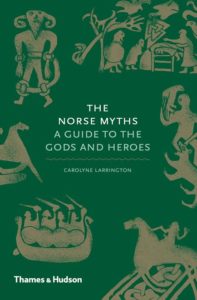Gods and goddesses; mighty heroes and indomitable women; dragons, serpents and cosmic wolves; the great World-Tree, inhabited by magical and monstrous creatures . . . .
The new Lucas or Spielberg film? Hardly. These are Norse myths, and they speak to us as vibrantly today as when they were told in Viking halls centuries ago. Originating in ancient Scandinavia and Iceland, they were recorded in sagas and poems, and in the (less approving) accounts of medieval Christian writers. Archaeology also gives us tantalizing depictions of Viking ships, eight-legged horses, and titanic battles on runestones, metalwork and carvings. Sounds Greek to you? Through The Norse Myths: A Guide to the Gods and Heroes (Thames & Hudson, $24.95), literature scholar Carolyne Larrington brings us vivid new translations from the Old Norse, and we meet the inhabitants of this rich mythological cosmos face to face. The book is an exhilarating introduction to the vivid, violent, boisterous world of the Norse myths and their cultural legacy—from Tolkien to Game of Thrones.
Through The Norse Myths: A Guide to the Gods and Heroes (Thames & Hudson, $24.95), literature scholar Carolyne Larrington brings us vivid new translations from the Old Norse, and we meet the inhabitants of this rich mythological cosmos face to face. The book is an exhilarating introduction to the vivid, violent, boisterous world of the Norse myths and their cultural legacy—from Tolkien to Game of Thrones.
Beginning with an account of the Norse myths’ origins and survival, The Norse Myths continues by introducing the principal gods and goddesses—Óṍinn (Odin), Loki, Þórr (Thor), Freyja, Heimdallr and the rest—before examining the gods’ powerful adversaries, the giants of ice and fire. According to the Norse creation myths, the world was born, and continued, in violence; two chapters are devoted to the (mis)adventures of the men and women of heroic legend and their sometimes unsettling conceptions of heroism and sacrifice. The last chapter is, fittingly, dedicated to ragnarök—the final conflict in which most of the gods will die and the world come to an end, with a hint at the possibility of rebirth.
The book offers fresh retellings of the vivid, often funny, almost always bloodthirsty tales of the Norse gods and heroes, and a satisfying exploration of their meaning and significance, past and present. The old stories have found new life in the work of Wagner, William Morris and J.R.R. Tolkien, and even in the reimagining of the fimbulvetr, or “Mighty Winter,” in Game of Thrones. And the 102 illustrations are an extra treat!
